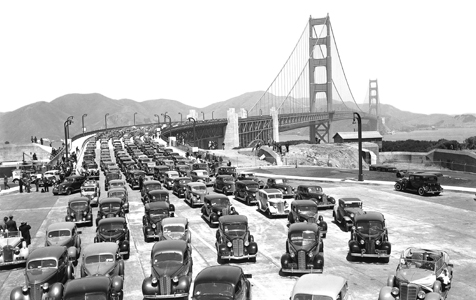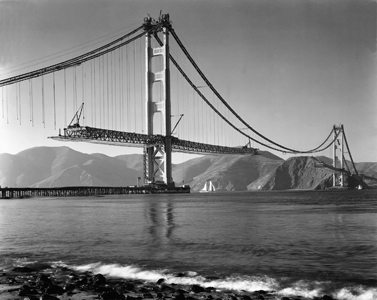Spanish explorers called it La Boca, or “the mouth.” Later, General Freemont called it the Golden Gate.

Traffic crosses the Golden Gate Bridge for the first time on opening day, May 27, 1937. Photo used with permission from Golden Gate Bridge, www.goldengate.org
By Wes Starratt, PE
Published: April, 2010
Spanish explorers called it La Boca, or “the mouth.” Later, General Freemont called it the Golden Gate.
Because of the distance, the winds, and the tides, for many years it was thought that the Golden Gate couldn’t be bridged. Engineers, however, came to believe that it could be. So property owners on both sides of the Golden Gate mortgaged their homes and businesses, sold bonds, and raised sufficient funds to build what at the time was the world’s longest suspension bridge.
As bridge traffic grew, bus and ferry services were added, and the Golden Gate Bridge and Highway District became the Golden Gate Bridge, Highway and Transportation District. This month, Bay Crossings takes a special look at the illustrious history of this unique organization.
After the Great Depression years, economic stimulus programs put in place state and federal funding that would lead to the Bay Bridge. But, while there was enormous enthusiasm on the local and state levels to connect Oakland and San Francisco, there was little corresponding enthusiasm to connect San Francisco with bucolic Marin. A further obstacle was that the shores on both sides of the Golden Gate were not state lands, but federal lands under the control of the War Department, which was concerned about any structure that could block the entrance to San Francisco Bay. So, the state showed little interest in any project to bridge the Golden Gate. But pressure to do just that was growing in the North Bay.
For the next part of the story, we turn to the words of bridge engineer Howard Schirmer in A Salute to Bridge Engineering, a publication of the American Society of Civil Engineers on the occasion of the 50th Anniversary of the Golden Gate Bridge in 1987.
Schirmer wrote, “In 1923, Frank Doyle, banker and president of the Santa Rosa Chamber of Commerce, chaired a meeting of representatives from San Francisco and the North Bay counties. This was the first public meeting called to find ways and means of financing this great project.” Schirmer explained that the “Bridging the Golden Gate Association” devoted itself to a “Bridge the Gate” funding campaign. From that program, the Golden Gate Bridge and Highway District developed, as it became evident that the bridge would have to be an inter-county endeavor involving San Francisco as well as the North Bay.
Schirmer continued, “In rapid succession came the necessary legislation to create the tax district for financing by the property owners of six counties: San Francisco, Del Norte, Marin, part of Mendocino, Sonoma, and part of Napa. On May 25, 1923, the Act became law.”
Subsequently, the parties made an application to the Secretary of War for a permit to build the bridge across the Golden Gate and on federal properties at both ends. A provisional permit was granted on Dec. 24, 1924. But, for several years, the District was embroiled in litigation with ferry interests over the proposed bridge. Finally, the District prevailed in December 1928 and the plan moved forward.
Voters approved the $35 million bond issue in November 1930. Joseph Strauss, chief engineer for the bridge, met with Bank of America’s A. P. Giannini, stressing the importance of the bridge to the region’s future. Giannini reacted by saying, “We’ll take the bonds.” The bonds sold, the groundbreaking took place on February 5, 1933, and the first automobiles rolled across the Golden Gate Bridge on May 27, 1937.
Since then, the Golden Gate Bridge and Highway District has maintained and upgraded the bridge in its very hostile environment of salt-laden winds and heavy ocean currents, and also responded to the ever-increasing traffic on the bridge. Thus, in 1977, the District officially became the Golden Gate Bridge, Highway And Transportation District, inaugurating local and regional bus service and establishing the first high-speed ferry service on San Francisco Bay, with terminals in Larkspur Landing, Sausalito, and San Francisco’s Ferry Building. These transportation systems continue to function, providing fast, efficient transportation both in the North Bay and across the Bay.
The Bridge District’s general manager, Celia Kupersmith, described her organization’s role: “The big picture is that we are responsible for the Golden Gate Bridge and for both bus and ferry services that connect San Francisco and Marin counties, as well as bus services within Marin County, including the operation of the bus terminal in downtown San Rafael, and the bus routes that connect Marin and Sonoma counties.”
To support these services, as well as to maintain and upgrade the bridge itself, the Golden Gate Bridge, Highway And Transportation District has been forced to rely not only on funding from federal and state sources, but also on increased bridge tolls.
Dietrich Stroeh, a professional engineer in Marin County and a member of the Board of Directors of the Bridge District, explained the public’s reaction to increased tolls: “They complain, but when you explain that the tolls subsidize the ferry service as well as local bus systems in Marin and Sonoma counties and express buses to San Francisco, most people understand.”
Furthermore, the district needs funds for the bridge itself, including routine maintenance as well as the ongoing $660-million seismic upgrading program that will take several more years to complete. Some federal funding is involved, but the program is largely unknown to most people because the work is largely being done quietly and out of sight.
“When the program is completed, the bridge will be able to withstand an 8.2-magnitude earthquake,” Stroeh said. “In many respects, the bridge has actually been rebuilt and is in better shape than when it was completed. The seismic retrofit program has brought the bridge up to standards that were not even in effect when it was built.”
Brian Sobel, former chairman of the Sonoma County Transportation Authority and current member of the Bridge District’s Board of Directors, described the financial picture and the reasons for the toll increases: “People get more upset over the tolls than any other thing, but the reality is that the Bridge District isn’t just maintaining the bridge, it is also running a very important bus fleet and a ferry fleet, both of which operate in deficits. The tolls that are paid on the bridge are what pays for everything. I tell people that we have one of the finest bus and ferry systems in the western United States, along with a world-class bridge, and all are operated and maintained very efficiently.”
Then, there is the proposed commuter railroad, Sonoma Marin Area Rapid Transit (SMART), that would run northward from the Larkspur Landing Ferry Terminal to Santa Rosa and beyond. Kupersmith said, “We are the agency that led the effort in the 1980s and 1990s to buy up the railroad right-of-way and then gave the right-of-way to SMART. We didn’t get paid for it, but, by virtue of that contribution, we now have two seats on the SMART Board of Directors.”
Mike Kerns, a member of the Sonoma County Board of Supervisors, responded to our questions regarding the Bridge District, stressing that the relationship between the County and the Bridge District “has been a very positive and very cooperative and collaborative relationship. For my last 11 years as a Sonoma County Supervisor, we have worked very cooperatively with the District on many different issues and built a very good relationship.”
Kerns discussed the Larkspur Ferry service and Port Sonoma: “The ferry system is actually working quite well. Ridership is down a little bit right now, but that is indicative of the economy, and overall the ferry system is doing quite well. We are still working on Port Sonoma. The staff of the Bridge District has been interested in perhaps extending ferry service there. I think that it would be a great benefit to the entire region.”
We also talked with Charles McGlashan, a member of the Marin County Board of Supervisors serving on the Bridge District’s Board of Directors, who commented, “We would still be in the stone age relative to transit service, were it not for the able partnership that the Bridge District provides.”
McGlashan continued, “The North Bay counties are able to implement local bus transportation policies by virtue of being able to hook up with the Golden Gate Transit buses and the ferry system to get cars off the road in our local communities. The Bridge District does all of our intra-county bus transportation service on a contract basis with the Marin Transit Agency (MTA), and that is a very valuable service for the people of Marin.”
Al Boro, the Bridge District’s Board President and the mayor of San Rafael, had this to say about the organization: “Thus, across the entire gamut of transportation issues facing the North Bay, whether it is providing commuter bus and ferry service as a means of reducing traffic on the bridge, or providing local bus service by contract to local communities, or providing the railroad right-of-way for a new commuter railroad, or maintaining and upgrading a world-class icon like the Golden Gate Bridge itself, the Golden Gate Bridge, Highway And Transportation District continues to serve not only the people of the North Bay and the entire Bay Area, but also the people of the world who come to visit one of the world’s great engineering achievements, the Golden Gate Bridge!”

Building the bridge that crossed the Golden Gate. Photo used with permission from Golden Gate Bridge, www.goldengate.org

